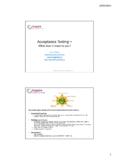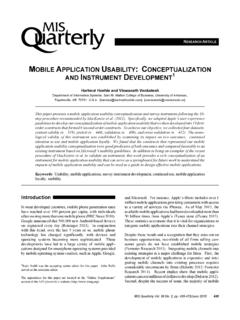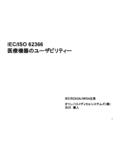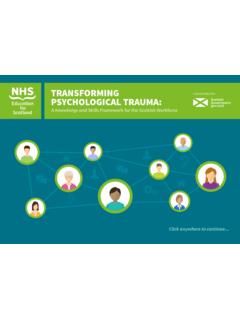Transcription of Food and Drug Administration Staff - ecompliance.co.jp
1 Food and Drug Administration Staff This guidance represents the Food and Drug Administration 's (FDA's) current thinking on this topic. It does not create or confer any rights for or on any person and does not operate to bind FDA or the public. You can use an alternative approach if the approach satisfies the requirements of the applicable statutes and regulations. If you want to discuss an alternative approach, contact the FDA Staff responsible for implementing this guidance. If you cannot identify the appropriate FDA Staff , call the appropriate number listed on the title page of this guidance.
2 1. Introduction FDA has developed this guidance document to assist industry in following appropriate human factors and usability engineering processes to maximize the likelihood that new medical devices will be safe and effective for the intended users, uses and use environments. FDA The recommendations in this guidance document are intended to support manufacturers in improving the design of devices to minimize potential use errors and resulting harm.
3 The FDA believes that these recommendations will enable manufacturers to assess and reduce risks associated with medical device use. FDA FDA's guidance documents, including this one, do not establish legally enforceable responsibilities. Instead, guidance documents describe the Agency's current thinking on a topic and should be viewed only as recommendations unless specific regulatory or statutory requirements are cited.
4 The use of the word should in Agency guidance documents means that something is suggested or recommended, but not required. FDA Should 2. Scope This guidance recommends that manufacturers follow human factors or usability engineering processes during the development of new medical devices, focusing specifically on the user interface, where the user interface includes all points of interaction between the product and the user(s) including elements such as displays, controls, packaging, product labels, instructions for use, etc.
5 While following these processes can be beneficial for optimizing user interfaces in other respects ( , maximizing ease of use, efficiency, and user satisfaction), FDA is primarily concerned that devices are safe and effective for the intended users, uses, and use environments. The goal is to ensure that the device user interface has been designed such that use errors that occur during use of the device that could cause harm or degrade medical treatment are either eliminated or reduced to the extent possible.
6 FDA As part of their design controls, manufacturers conduct a risk analysis that includes the risks associated with device use and the measures implemented to reduce those risks.
7 ANSI/AAMI/ISO 14971, Medical Devices Application of risk management to medical devices, defines risk as the combination of the probability of occurrence of harm and the severity of the potential harm2. However, because probability is very difficult to determine for use errors, and in fact many use errors cannot be anticipated until device use is simulated and observed, the severity of the potential harm is more meaningful for determining the need to eliminate (design out) or reduce resulting harm.
8 If the results of risk analysis indicate that use errors could cause serious harm to the patient or the device user, then the manufacturer should apply appropriate human factors or usability engineering processes according to this guidance document. This is also the case if a manufacturer is modifying a marketed device to correct design deficiencies associated with use, particularly as a corrective and preventive action (CAPA). ANSI/AAMI/ISO 14971.
9 Medical Devices Application of risk management to medical devices ANSI/AAMI/ISO 14971 CAPA) CDRH considers human factors testing a valuable component of product development for medical devices.
10 CDRH recommends that manufacturers consider human factors testing for medical devices as a part of a robust design control subsystem. CDRH believes that for those devices where an analysis of risk indicates that users performing tasks incorrectly or failing to perform tasks could result in serious harm, manufacturers should submit human factors data in premarket submissions ( , PMA, 510(k)). In an effort to make CDRH s premarket submission expectations clear regarding which device types should include human factors data in premarket submissions, CDRH is issuing a draft guidance document List of Highest Priority Devices for Human Factors Review, Draft Guidance for Industry and Food and Drug Administration Staff .











